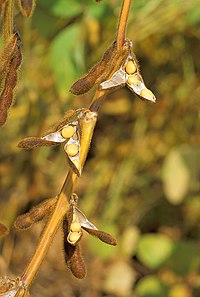
Photo from wikipedia
Soybean rust, caused by the biotrophic fungus Phakopsora pachyrhizi, is the most important foliar disease of soybean (Glycine max) worldwide. Deployment of resistant soybean cultivars is the best option for… Click to show full abstract
Soybean rust, caused by the biotrophic fungus Phakopsora pachyrhizi, is the most important foliar disease of soybean (Glycine max) worldwide. Deployment of resistant soybean cultivars is the best option for managing this disease. Genes conferring resistance to P. pachyrhizi have been identified, but pathotypes of the rust fungus overcoming these resistance genes have been found as well. To identify novel resistance genes, soybean genotypes from both local and international sources were screened at multiple locations in Tanzania and Uganda in 2016 and 2017. The results from this screening revealed that infection types, disease severities and sporulation levels varied among the genotypes and locations. The majority of the genotypes had tan‐colored (TAN) lesions and developed moderate sporulation, implying susceptibility, while only seven of the 71 lines had reddish brown (RB) lesions and showed low disease severities in all of the screening environments. We identified seven genotypes that were the most resistant to rust in the most locations over the two years. These genotypes will be useful for further studies and, ultimately, for rust management as they show broad resistance to various pathotypes of the rust fungus.
Journal Title: Plant Pathology
Year Published: 2021
Link to full text (if available)
Share on Social Media: Sign Up to like & get
recommendations!